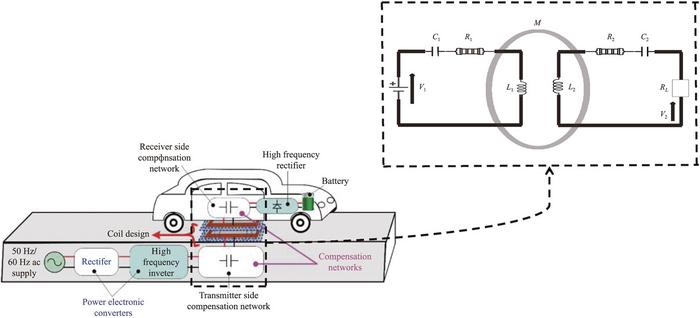As the global community intensifies its efforts to combat climate change, the rise of electric vehicles (EVs) is undeniably a significant step toward sustainable transportation. EVs offer a cleaner, more efficient alternative to traditional fossil fuel-powered vehicles, yet the transition faces hurdles in infrastructural development, particularly concerning charging solutions. Wireless Power Transfer (WPT) technology emerges as a beacon of hope, promising to address these limitations by eliminating the need for physical connections and enabling a more seamless charging experience. Among various WPT methods, Inductive Power Transfer (IPT) has garnered attention for its reliability and efficiency in the transfer of energy without direct contact, making it an attractive option for EV charging.
Recent research has focused on enhancing the efficiency of IPT systems through innovative design approaches. One pivotal study delves into the optimization of circular coils embedded with ferrite cores, highlighting how these advancements can significantly improve the efficiency of wireless power transfer for electric vehicles. The challenges faced by traditional coil designs—misalignment tolerance and electromagnetic field (EMF) dispersion—have prompted researchers to seek methods that optimize performance while maintaining cost-effectiveness.
The study revealed impressive strides in wireless charging efficiency, attributing these gains to refined coil designs that incorporate ferrite boxes. This integration resulted in a remarkable increase in coupling efficiency by 50%, coupled with a threefold enhancement in EMF strength. These advancements ensure that the magnetic field is directed optimally, reducing energy losses that typically occur during power transfer and ensuring a more consistent and reliable source of energy for EVs.
To further ascertain the effectiveness of these designs, the researchers conducted tests on two distinct configurations: an equivalent configuration featuring uniform coil sizes and an inequivalent design that employed an enlarged transmitting coil. The results were striking. The equivalent design, enhanced with ferrite boxes, achieved an impressive 95% energy efficiency level at a lower cost—a compelling solution for standardized applications across various sectors. On the other hand, the inequivalent design showcased superior misalignment tolerance, effectively increasing the coupling coefficient and the strength of the EMF, vital factors for practical implementations in everyday scenarios where perfect alignment is often unfeasible.
Simulations conducted using ANSYS software corroborated these findings, confirming that the ferrite cores not only boost performance metrics but also provide a more cost-effective alternative to traditional, bulkier coil systems often employed in WPT applications. One of the key benefits of incorporating ferrite boxes is their ability to direct EMF waves more effectively, subsequently diminishing unnecessary field dispersion—a significant concern in wireless energy systems aiming for high efficiency.
This groundbreaking research does not only carry implications for the domain of electric vehicles. The potential applications extend widely into diverse fields, such as consumer electronics, industrial applications, and even medical device technology. The advancement of ferrite-coil systems can revolutionize the way we think about wireless charging across various industries, setting the stage for a future of technology that is both efficient and environmentally conscious.
Looking forward, the study suggests that real-world testing of dynamic charging systems is a crucial next step, particularly for infrastructure such as embedded road coils that could provide continuous charging to EVs in motion. Such innovations are paramount for scaling EV adoption, especially in contexts like highway charging lanes where precise alignment is often impractical. The misalignment tolerance aspect of the inequivalent design proves to be a game changer, addressing a real-world complication that could expedite the implementation of WPT systems in an urban environment.
Ultimately, this research signifies a substantial leap in wireless power transfer technology, merging concepts of sustainability with cutting-edge engineering. By re-envisioning coil design and implementing ferrite optimization, the researchers have successfully overcome longstanding barriers associated with energy efficiency and alignment. The pursuit of greener energy solutions continues to gather momentum, and technologies that facilitate the transition toward a fully electric automotive landscape are more vital than ever.
As the world strides toward a future where electric vehicles dominate the transportation sector, technologies like those discussed in this study are poised to play a pivotal role. Institutions and industries focused on sustainability would do well to take note of these advancements and consider how they might integrate such innovations into their own operational models. The notable increases in efficiency and reductions in energy loss present a clear case for the adoption and advancement of wireless power transfer systems.
This optimization research, therefore, not only contributes to the ongoing discourse on electric vehicle technology but also illustrates the broader application of electromagnetic energy transfer techniques across multiple sectors. It accentuates the importance of interdisciplinary research that seeks to enhance current systems while prioritizing environmental responsibility. The findings hold promise for transforming not just the EV market but also the myriad of applications that would benefit from optimized wireless energy solutions.
In conclusion, as research into wireless power transfer technology progresses, one can anticipate a future where EV charging becomes more accessible, efficient, and user-friendly. The ongoing commitment from researchers and institutions to improve such technologies will undoubtedly pave the way for the next generation of sustainable transportation solutions, aligning perfectly with global initiatives aimed at reducing carbon footprints and enhancing energy efficiency.
—
Subject of Research: Optimization of circular coils with ferrite boxes for enhanced efficiency in wireless power transfer for electric vehicles
Article Title: Optimization of circular coils with ferrite boxes for enhanced efficiency in wireless power transfer for electric vehicles
News Publication Date: 7-Feb-2025
Web References:
References:
Image Credits: GREEN ENERGY AND INTELLIGENT TRANSPORTATION
Keywords
Tags: advancements in electric vehicle technologyclimate change and electric vehiclescost-effective EV charging methodselectric vehicle charging solutionselectromagnetic field dispersion solutionsenhancing wireless charging efficiencyferrite-coil optimization techniquesinductive power transfer systemsovercoming EV charging infrastructure challengesseamless charging experience for EVssustainable transportation innovationswireless power transfer technology





